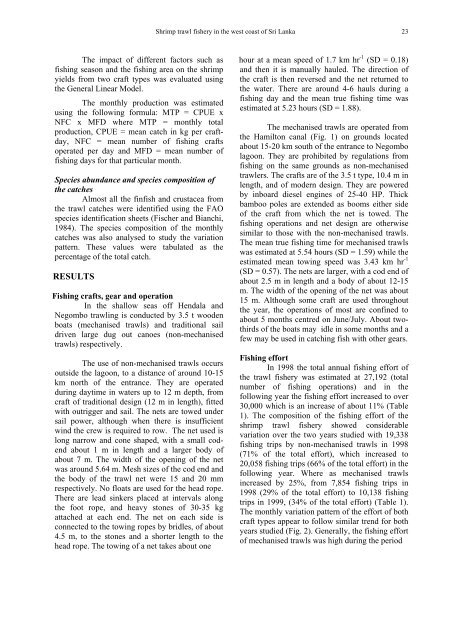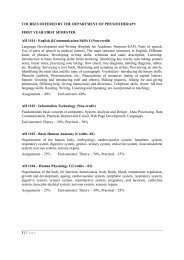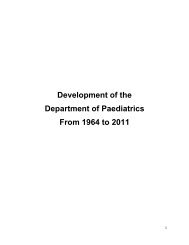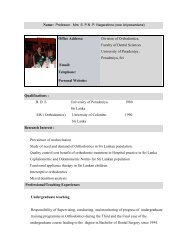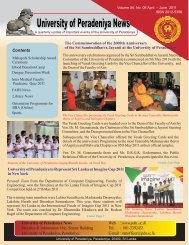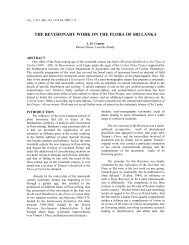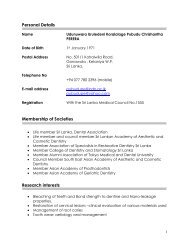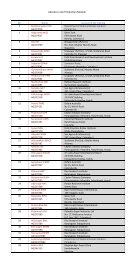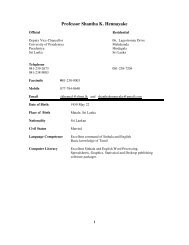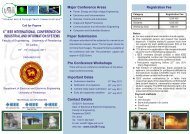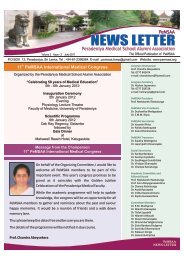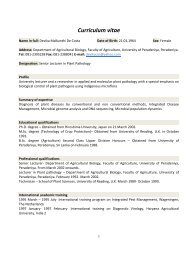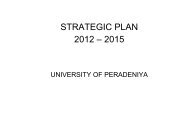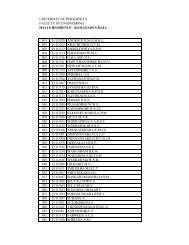PRESENT STATUS OF THE SHRIMP TRAWL FISHERY IN THE ...
PRESENT STATUS OF THE SHRIMP TRAWL FISHERY IN THE ...
PRESENT STATUS OF THE SHRIMP TRAWL FISHERY IN THE ...
You also want an ePaper? Increase the reach of your titles
YUMPU automatically turns print PDFs into web optimized ePapers that Google loves.
Shrimp trawl fishery in the west coast of Sri Lanka 23<br />
The impact of different factors such as<br />
fishing season and the fishing area on the shrimp<br />
yields from two craft types was evaluated using<br />
the General Linear Model.<br />
The monthly production was estimated<br />
using the following formula: MTP = CPUE x<br />
NFC x MFD where MTP = monthly total<br />
production, CPUE = mean catch in kg per craftday,<br />
NFC = mean number of fishing crafts<br />
operated per day and MFD = mean number of<br />
fishing days for that particular month.<br />
Species abundance and species composition of<br />
the catches<br />
Almost all the finfish and crustacea from<br />
the trawl catches were identified using the FAO<br />
species identification sheets (Fischer and Bianchi,<br />
1984). The species composition of the monthly<br />
catches was also analysed to study the variation<br />
pattern. These values were tabulated as the<br />
percentage of the total catch.<br />
RESULTS<br />
Fishing crafts, gear and operation<br />
In the shallow seas off Hendala and<br />
Negombo trawling is conducted by 3.5 t wooden<br />
boats (mechanised trawls) and traditional sail<br />
driven large dug out canoes (non-mechanised<br />
trawls) respectively.<br />
The use of non-mechanised trawls occurs<br />
outside the lagoon, to a distance of around 10-15<br />
km north of the entrance. They are operated<br />
during daytime in waters up to 12 m depth, from<br />
craft of traditional design (12 m in length), fitted<br />
with outrigger and sail. The nets are towed under<br />
sail power, although when there is insufficient<br />
wind the crew is required to row. The net used is<br />
long narrow and cone shaped, with a small codend<br />
about 1 m in length and a larger body of<br />
about 7 m. The width of the opening of the net<br />
was around 5.64 m. Mesh sizes of the cod end and<br />
the body of the trawl net were 15 and 20 mm<br />
respectively. No floats are used for the head rope.<br />
There are lead sinkers placed at intervals along<br />
the foot rope, and heavy stones of 30-35 kg<br />
attached at each end. The net on each side is<br />
connected to the towing ropes by bridles, of about<br />
4.5 m, to the stones and a shorter length to the<br />
head rope. The towing of a net takes about one<br />
hour at a mean speed of 1.7 km hr -1 (SD = 0.18)<br />
and then it is manually hauled. The direction of<br />
the craft is then reversed and the net returned to<br />
the water. There are around 4-6 hauls during a<br />
fishing day and the mean true fishing time was<br />
estimated at 5.23 hours (SD = 1.88).<br />
The mechanised trawls are operated from<br />
the Hamilton canal (Fig. 1) on grounds located<br />
about 15-20 km south of the entrance to Negombo<br />
lagoon. They are prohibited by regulations from<br />
fishing on the same grounds as non-mechanised<br />
trawlers. The crafts are of the 3.5 t type, 10.4 m in<br />
length, and of modern design. They are powered<br />
by inboard diesel engines of 25-40 HP. Thick<br />
bamboo poles are extended as booms either side<br />
of the craft from which the net is towed. The<br />
fishing operations and net design are otherwise<br />
similar to those with the non-mechanised trawls.<br />
The mean true fishing time for mechanised trawls<br />
was estimated at 5.54 hours (SD = 1.59) while the<br />
estimated mean towing speed was 3.43 km hr -1<br />
(SD = 0.57). The nets are larger, with a cod end of<br />
about 2.5 m in length and a body of about 12-15<br />
m. The width of the opening of the net was about<br />
15 m. Although some craft are used throughout<br />
the year, the operations of most are confined to<br />
about 5 months centred on June/July. About twothirds<br />
of the boats may idle in some months and a<br />
few may be used in catching fish with other gears.<br />
Fishing effort<br />
In 1998 the total annual fishing effort of<br />
the trawl fishery was estimated at 27,192 (total<br />
number of fishing operations) and in the<br />
following year the fishing effort increased to over<br />
30,000 which is an increase of about 11% (Table<br />
1). The composition of the fishing effort of the<br />
shrimp trawl fishery showed considerable<br />
variation over the two years studied with 19,338<br />
fishing trips by non-mechanised trawls in 1998<br />
(71% of the total effort), which increased to<br />
20,058 fishing trips (66% of the total effort) in the<br />
following year. Where as mechanised trawls<br />
increased by 25%, from 7,854 fishing trips in<br />
1998 (29% of the total effort) to 10,138 fishing<br />
trips in 1999, (34% of the total effort) (Table 1).<br />
The monthly variation pattern of the effort of both<br />
craft types appear to follow similar trend for both<br />
years studied (Fig. 2). Generally, the fishing effort<br />
of mechanised trawls was high during the period


